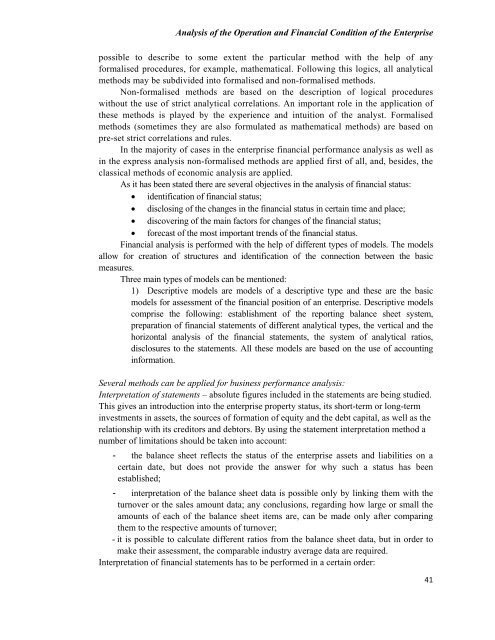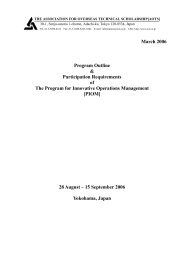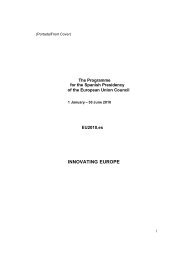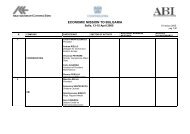Analysis of the Operation and Financial Condition of the Enterprise
Analysis of the Operation and Financial Condition of the Enterprise
Analysis of the Operation and Financial Condition of the Enterprise
Create successful ePaper yourself
Turn your PDF publications into a flip-book with our unique Google optimized e-Paper software.
<strong>Analysis</strong> <strong>of</strong> <strong>the</strong> <strong>Operation</strong> <strong>and</strong> <strong>Financial</strong> <strong>Condition</strong> <strong>of</strong> <strong>the</strong> <strong>Enterprise</strong>possible to describe to some extent <strong>the</strong> particular method with <strong>the</strong> help <strong>of</strong> anyformalised procedures, for example, ma<strong>the</strong>matical. Following this logics, all analyticalmethods may be subdivided into formalised <strong>and</strong> non-formalised methods.Non-formalised methods are based on <strong>the</strong> description <strong>of</strong> logical procedureswithout <strong>the</strong> use <strong>of</strong> strict analytical correlations. An important role in <strong>the</strong> application <strong>of</strong><strong>the</strong>se methods is played by <strong>the</strong> experience <strong>and</strong> intuition <strong>of</strong> <strong>the</strong> analyst. Formalisedmethods (sometimes <strong>the</strong>y are also formulated as ma<strong>the</strong>matical methods) are based onpre-set strict correlations <strong>and</strong> rules.In <strong>the</strong> majority <strong>of</strong> cases in <strong>the</strong> enterprise financial performance analysis as well asin <strong>the</strong> express analysis non-formalised methods are applied first <strong>of</strong> all, <strong>and</strong>, besides, <strong>the</strong>classical methods <strong>of</strong> economic analysis are applied.As it has been stated <strong>the</strong>re are several objectives in <strong>the</strong> analysis <strong>of</strong> financial status: identification <strong>of</strong> financial status; disclosing <strong>of</strong> <strong>the</strong> changes in <strong>the</strong> financial status in certain time <strong>and</strong> place; discovering <strong>of</strong> <strong>the</strong> main factors for changes <strong>of</strong> <strong>the</strong> financial status; forecast <strong>of</strong> <strong>the</strong> most important trends <strong>of</strong> <strong>the</strong> financial status.<strong>Financial</strong> analysis is performed with <strong>the</strong> help <strong>of</strong> different types <strong>of</strong> models. The modelsallow for creation <strong>of</strong> structures <strong>and</strong> identification <strong>of</strong> <strong>the</strong> connection between <strong>the</strong> basicmeasures.Three main types <strong>of</strong> models can be mentioned:1) Descriptive models are models <strong>of</strong> a descriptive type <strong>and</strong> <strong>the</strong>se are <strong>the</strong> basicmodels for assessment <strong>of</strong> <strong>the</strong> financial position <strong>of</strong> an enterprise. Descriptive modelscomprise <strong>the</strong> following: establishment <strong>of</strong> <strong>the</strong> reporting balance sheet system,preparation <strong>of</strong> financial statements <strong>of</strong> different analytical types, <strong>the</strong> vertical <strong>and</strong> <strong>the</strong>horizontal analysis <strong>of</strong> <strong>the</strong> financial statements, <strong>the</strong> system <strong>of</strong> analytical ratios,disclosures to <strong>the</strong> statements. All <strong>the</strong>se models are based on <strong>the</strong> use <strong>of</strong> accountinginformation.Several methods can be applied for business performance analysis:Interpretation <strong>of</strong> statements – absolute figures included in <strong>the</strong> statements are being studied.This gives an introduction into <strong>the</strong> enterprise property status, its short-term or long-terminvestments in assets, <strong>the</strong> sources <strong>of</strong> formation <strong>of</strong> equity <strong>and</strong> <strong>the</strong> debt capital, as well as <strong>the</strong>relationship with its creditors <strong>and</strong> debtors. By using <strong>the</strong> statement interpretation method anumber <strong>of</strong> limitations should be taken into account:- <strong>the</strong> balance sheet reflects <strong>the</strong> status <strong>of</strong> <strong>the</strong> enterprise assets <strong>and</strong> liabilities on acertain date, but does not provide <strong>the</strong> answer for why such a status has beenestablished;- interpretation <strong>of</strong> <strong>the</strong> balance sheet data is possible only by linking <strong>the</strong>m with <strong>the</strong>turnover or <strong>the</strong> sales amount data; any conclusions, regarding how large or small <strong>the</strong>amounts <strong>of</strong> each <strong>of</strong> <strong>the</strong> balance sheet items are, can be made only after comparing<strong>the</strong>m to <strong>the</strong> respective amounts <strong>of</strong> turnover;- it is possible to calculate different ratios from <strong>the</strong> balance sheet data, but in order tomake <strong>the</strong>ir assessment, <strong>the</strong> comparable industry average data are required.Interpretation <strong>of</strong> financial statements has to be performed in a certain order:41
















